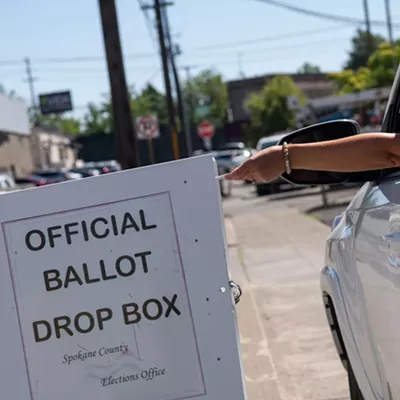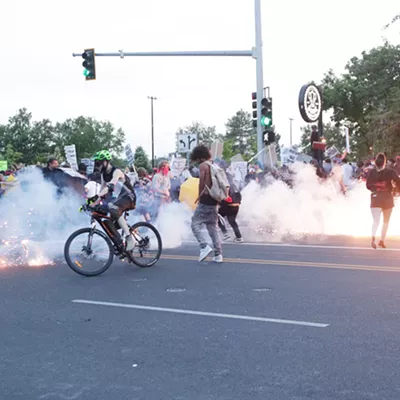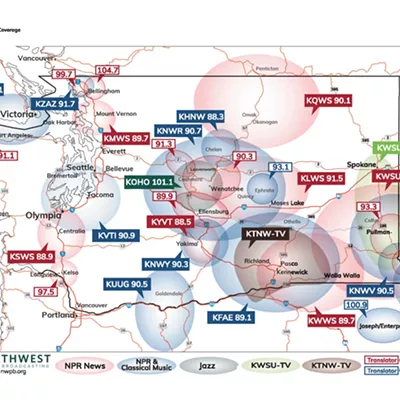The bell sounds and East Valley Middle School floods with adolescent chaos — with pre-teen murmurs, slammed lockers, playful punches.
Seventh-grader Hannah Smith finds middle school fun but isn’t a fan of the social drama, the verbal bullying and the glares. For sixth-grader Drew Ness, the transition to middle school was “confusing” — what with all the choices and new students.
“When you first come here, you’re the smallest,” eighth-grader Ian Spendlove says.
“You’re terrified.” Within a few months, though, he loved it.
But soon, “middle school” — as a location, as a concept — will be eliminated from the East Valley School District.
After a whirlwind year, the school board has mandated the closure of East Valley Middle School and Mountain View Middle School. In a few years, East Valley elementary schools will stretch from preschool all the way through eighth grade.
To improve education, Superintendent John Glenewinkel believes, East Valley needed a seismic change. And a seismic change he got, with all the loud, earthshaking, community-fracturing tremors that come with it.
MAKING HIS CASE
Glenewinkel has only been superintendent for three years, but already he’s made enemies. “They see me as a bully,” he says of some of his critics, as he sits in his office. On his desk is a copy of the book Switch: How to Change When Change is Hard. “They see me, frankly, as tilting at windmills. ‘Give him time and he’ll burn himself out.’” It’s not hard to imagine how some could be intimidated by the East Valley superintendent — a large, bearded Texas native.
But others, he says, see him as demonstrating “enormous courage and fortitude.” Glenewinkel freely hands out his home phone number. He engages his opponents with lengthy e-mails and personal meetings.
Yeah, change is hard. But in a July newsletter, Glenewinkel laid out the statistical case for a major change: Only 76 percent of East Valley students graduate, only 53 percent go to college and — eight years after graduation — only about 25 percent had a college degree. Worse, Glenewinkel believes that number is trending downward.
True, East Valley’s standardized test scores are solid in writing, and improving in science. But East Valley Middle School has failed the last three years to achieve the federally required “adequate yearly progress” on its standardized math tests.
Last year, only about 36 percent of East Valley 10th-grade students met the state standard for math.
Meanwhile, the past four East Valley school bonds have failed. Blame declining enrollment, or 1999’s Kaiser layoffs, but the community hasn’t approved a bond since 1996. The state said six out of eight East Valley schools were in need of major renovation — four years ago.
But with East Valley’s educational struggles, “it makes no sense to ask voters for a new building to do the same thing,” Glenewinkel says. He needed to offer them change.
DEFINING CHANGE
To decide what that change would look like, Glenewinkel created three advisory committees last February: one for high school, one for middle school, and one for elementary. At the very first meeting, Glenewinkel asked the middle school “re-visioning” committee, “Do we need middle school?” The leap from elementary to middle school is one of the riskiest moments in a student’s academic career, Glenewinkel argues.
A National Association of School Psychologists study reports dangers of decreased academic self-esteem, social confidence and parent involvement in middle school. That’s precisely the time when the close community of an elementary school could help, Glenewinkel says. Fewer kids would fall between the cracks, in other words, if there were fewer cracks.
Nationwide, there are only about 5,000 K-8 schools, but they’ve become one of the hottest new educational trends. Schools in New York, Chicago and Philadelphia are switching over. While comparisons can be inexact, one study found that freshman students who had attended middle schools received grades that were, on average, two full points lower than those who had attended K-8 schools.
Yet research shows that smaller schools — while they have fewer electives — improve graduation rates, attendance and teacher collaboration. And restructuring East Valley’s elementary schools would actually add 216 news students to each. (Glenewinkel argues that the size of the new schools would be optimal.)
In June 2010, the middle school committee refused, by a 3-7 vote, to recommend ditching middle school for a pre-K-8 model. But the elementary committee supported it, and the school board officially mandated the pre-K-8 model at a school board meeting on Jan. 4.
TEACHERS ARE UNCERTAIN
East Valley’s high school and middle school principals support the changes. But opinion among faculty is mixed. A union survey of 106 teachers found 55 percent wanted the district to “abandon re-visioning,” and 53 percent did not trust that the outcome would be positive for students.
Some of the anonymous survey comments accused the survey of bias. Others comments indicated bitter division.
From one anonymous teacher: “They are going to do what they want regardless. What is the point of ‘re-vision’ when the ones in power are blind?” For some, there have been consequences. A secretary was suspended for two days and required to write a formal retraction after she accused the board, in a Facebook post, of illegal activity.
But Norma Woodward, a second-grade teacher at East Falls elementary, says things have calmed down lately.
“I commend [Glenewinkel] for wanting to at least try something and get a good outcome,” Woodward says. She thinks the changes will bring about a crucial shift in atmosphere for students in the sixth, seventh and eighth grades.
East Valley Middle School language-arts teacher Julie Scott, however, worries that if the restructuring is a failure — and she believes it will be — it will be almost impossible to roll back.
“If he thinks this is the model to go to, then pilot it,” Scott says. She suggests changing only a few schools to pre-K-8, and leaving one middle school. But Glenewinkel says the idea was too complicated, logistically, for allocating resources and assigning students.
BAD INFLUENCES?
“It’s pitting parents against administration. Teachers against parents. Principals against parents,” says parent Stacy Montoya.
But this article may be the first some East Valley parents have heard about the plans. Scott points out that the district never mailed out any informative postcards. (In an e-mail to an opponent of restructuring, Glenewinkel said mailing information to all 10,000 voters in the district was deemed too expensive.) Instead, Scott says, handouts were sent home with students, who likely wadded them up in the bottoms of their backpacks and never showed them to parents.
“It’s pitting parents against administration. Teachers against parents. Principals against parents.”
Many parents who have heard about the plan are nervous about the impact older kids would have on younger ones.
“My [middle school-age] kids came home shocked about what they were hearing in school,” says Montoya. “Having a third grader … I can’t imagine them with the older kids.”
Similarly, the five students we talked to at East Valley Middle School all separately expressed the same concern: Some middle school kids cuss. They bully. They do drugs. Should little kids be exposed to that?
But parent Lynette Romney argues these troubled older kids will be influenced in positive ways by the younger ones.
“I’ve worked with the alternative middle school kids at the community garden. There was a girl who could not go three minutes without using the F-bomb,” she says. But then she gave that girl the responsibility to help out younger kids and immediately her behavior improved.
There is a loyal contingent of supportive parents — Glenewinkel says he recently went to a PTA meeting at which attendees wholeheartedly supported the idea. Then there are the frustrated parents, the ones who flood the “East Valley — Citizens for Accountable Education” Facebook Group with multiple posts a day, arguing against restructuring.
Sure enough, at the Jan. 4 school board meeting, they were there, waving protest signs. Glenewinkel says one community member left the meeting feeling frightened for her safety and her kids. He reports whispers of recall petitions to remove board members, of a pledge of $5,000 dollars for a campaign to challenge the $33-million school bond needed to ready the schools for K-8.
Glenewinkel agrees that the vote on the upcoming bond can give insight into how many people support his changes. But even if the bond doesn’t pass, he says, the reform will still go through — to the chagrin of some parents.
“We’re going to see about that,” Montoya says. “Groups like us are going to have to grow in such huge numbers they’re going to have to listen to us.”
But the district is out of options, Glenewinkel says, and there’s no doubt in his mind that, with this reform, he’s right. Still, he knows it may cost him his job.
“Superintendents and educators are always talking about the hill they’re willing to die on, but they never seem to find it,” Glenewinkel says. “This is the hill I’m sorta willing to die on.”

























